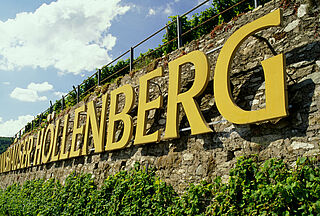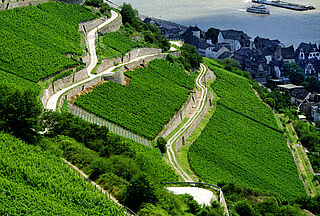Hoellenberg
Kendte vinmarker
Assmannshausens Hellishly Steep Site - Spätburgunder Par Excellence
Although the Rheingau is best known for its Riesling wines, the Spätburgunder (Pinot Noir) grape has also been cultivated here for centuries, particularly in the red wine enclave Assmannshausen. The town is situated about 4.5 km (3 miles) downstream from Rüdesheim, where the Rhine makes a sweeping bend and resumes its south-north course.
Historians assume that Assmannshausen and neighboring Aulhausen were settled by the Franks. The first documented mention of both towns dates from a deed of gift in 1108, when Archbishop Ruthard of Mainz gave Disibodenberg Monastery/Nahe a new vineyard located between “Hasemanneshusen” and “Ulinhusen” – the site of today’s famous vineyard Höllenberg.
Although some maintain that Assmannhausen’s red wine tradition dates from the 12th century and 1470 is said to mark the first written reference to “Klebrot” (a local Rheingau synonym for Spätburgunder) in the Rheingau, the first documented mention of red wine in Assmannshausen dates from 1507, in a manuscript from Kloster Marienhausen/Aulhausen, a Cistercian convent founded in 1180 under the patronage of Kloster Eberbach/Eltville. In a household register listing what the nuns were permitted to eat and drink on feast days, the rules for St. John’s Day (24 June) included “eine Kanne (1 liter) rothen Weyn von Assmannshausen.” (Note: Half a century earlier (1453), records from the same convent also mentioned Riesling in referring to its lease of property and “ruesseling” vines in Diebach/Mittelrhein on the opposite side of the Rhine.)
Höllenberg is a vine-clad cone some 55 ha (136 acres) in size with a south-southwest exposure. Traveling downstream from Rüdesheim it is impossible to “miss” it, as the name of the site is written on the face of the hillside in bold white letters. Spätburgunder is the predominant grape variety; a small amount of the early-ripening strain “Frühburgunder” is also cultivated here. The vines in some parcels are very old and/or clones imported from Burgundy; a small portion are ungrafted. The soils are weathered phyllite slate and Taunus quartzite – both of which lend the wines a distinct mineral tone. Due to soil porosity, the vines develop deep roots in their quest for moisture. With an inclination of between 40 to 60 percent, it is one of the region’s steepest sites – a fact that brings us to the origin of site’s name.
What’s in a Name?
The German word “Hölle” literally means “hell” and conjures up images of fire and brimstone, or in terms of wine, “fiery” growths – an apt description for some red wines. Etymological reality, however, dictates otherwise in this case: the name actually derives from “Halde,” meaning slope or steep hill in local Rheingau dialect. The same is true of the three other “Hölle” sites in the Rheingau (Johannisberg, Wiesbaden-Schierstein and Hochheim).
Assmannshäuser Höllenberg Spätburgunder wines have long enjoyed a following well beyond the borders of the Rheingau. It is one of the region’s classified sites and thus deemed suitable for producing “Erstes Gewächs” (First Growth), the Rheingau’s top quality category for dry wines. Yet, as contemporary German wine writer Oliver Beck points out (Zur Lage des Deutschen Weins, published by Klett Cotta/Stuttgart), not all Höllenberg wines reflect the site’s optimal potential. Four estates, however, consistently receive high marks for their quality-oriented practices (low yields; very selective hand harvesting) and stunning Höllenberg Spätburgunder wines. Collectively, they cultivate about 61 percent of the site.
Hessian State Wine Domains: Assmannshausen
With its ca. 23 ha (57 acres) of Spätburgunder (98%) and Frühburgunder (2%) vines, the state-owned property has the largest holdings in Höllenberg. The wines are vinified traditionally (fermentation on the skins) and aged in wood, both traditional (old) oak casks and small barriques. As heirs to the viticultural tradition of the Cistercian monks of Kloster Eberbach, the estate’s association with Höllenberg could well date from the 12th century, through its affiliation with the above-mentioned Kloster Marienhausen.
Hours: Friday + Saturday, noon–6 p.m. Closed: January.
The wines can also be sampled/purchased at the Vinothek (wine shop) at Kloster Eberbach (April–October, daily, 10 a.m.–6 p.m.; November–March, daily, 11 a.m.–5 p.m.) or in the historical press house in Eltville proper (Monday–Friday, 10 a.m.–6 p.m., Saturday, 10 a.m.–4 p.m.).
Contact: www.weingut-kloster-eberbach.de
The Three “K’s”
Weingut Robert König cultivates 2 ha (5 acres) of Spät- and Frühburgunder vines in Höllenberg and neighboring site Frankenthal (also a classified site). Robert König, Jr., uses traditional vinification methods and ages his reds in old oak casks. Tip: Gault Millau WeinGuide Germany 2007 (published by Christian Verlag/München) mentions the estate as being a reliable source of good Assmannshäuser red wines at very reasonable prices.
Hours: Monday–Friday, 8–noon, or by appointment.
Strausswirtschaft (wine pub with the estate’s wines + light fare): weekends and holidays in May and during the region’s “Tage der offenen Weinkeller” (open house) weekend in September.
Contact: www.weingut-robert-koenig.de
Weingut Krone’s 3.5 ha (8.6 acres) in Höllenberg are planted exclusively with old Spätburgunder vines (low yields), primarily of clones imported from Burgundy – in line with winemaker Peter Perabo’s goal to produce Burgundy-style red wines. The wines are aged in barriques of various ages in cellars carved some 60 meters beneath the Frankenthal site.
Hours: No sales at the estate proper, but rather at the Wegeler estate in Oestrich, responsible for marketing the Krone wines since December 2006.
Monday–Friday, 8 a.m.–5 p.m., Saturday, 11 a.m.–4 p.m.
The wines can also be sampled/purchased at the Hotel-Restaurant Krone in Assmannshausen or Hotel-Restaurant Kronenschlösschen in Hattenheim.
Contact: www.weingut-krone.de
August Kesseler was one of the first in the Rheingau to use barrique casks (mid-80s) and to export German red wine. He is particularly proud that his Spätburgunder wines are listed in many leading restaurants of the world and renowned shops, such as Harrod’s in London. Yields are low in his five ha (12 acres) of old Spätburgunder vines (partially ungrafted) in Höllenberg. The wines are aged in barriques of various ages in double-storied cellars that date from 1793. Critics’ remarks: Kesseler belongs to the “world league” of Pinot Noir producers.
Hours: by appointment only.
Contact: www.august-kesseler.de
Tips for Tourists
Hotel-Restaurant Krone, Rheinuferstrasse 10, 65385 Rüdesheim-Assmannshausen.
Historical house (1541/1808) and gourmet restaurant with lovely terrace facing the Rhine. All credit cards. www.hotel-krone.com
Hotel-Restaurant Jagdschloss Niederwald, 65385 Rüdesheim.
Formerly, a small hunting palace (1764), situated in a park not far from the Niederwald monument (i.e. on the heights above Rüdesheim/Assmannshausen; can be reached by chairlift from Assmannshausen, cable car from Rüdesheim, or via auto).
All credit cards. www.niederwald.de
Hotel-Restaurant Breuer’s Rüdesheimer Schloss, Drosselgasse/Steingasse 10, 65385 Rüdesheim.
In the town’s former tithe house, there are chic rooms, top wines and very good food – often accompanied by live music and dancing. Pretty seating in the courtyard.
All credit cards. www.ruedesheimer-schloss.com
For a fantastic view of the Rhine valley and the famous vineyards of both Rüdesheim and Assmannshausen, purchase a Ring Ticket (€10) for a chairlift ride and cable car ride to and from the Niederwald monument (commemorating the Franco-Prussian War), and a boat trip between Rüdesheim and Assmannshausen – a scenic, enjoyable circular tour.
Tickets are also available for just the chairlift or cable car (€6,50 roundtrip or €4,50 one way).
Adjacent to the monument, there is an Adlerwarte (hospital for wounded birds of prey + owl breeding station + falconry) as well as a small wildlife park (deer).


